Getting injured from running is no fun.
While injuries are common among runners, the good news is that, with the right approach, injury prevention is possible for many.
As a certified running coach, I am typically approached by recreational runners for one of two reasons.
Either the runner is looking for a training plan that will help them improve performance and run faster—or is looking for individualized coaching that will help prevent running injuries or at least reduce the risk of injury.
Distance runners seemingly have a fairly high injury risk, as running is a high-impact activity involving a repetitive motion. Most surveys and estimates in research literature1DAOUD, A. I., GEISSLER, G. J., WANG, F., SARETSKY, J., DAOUD, Y. A., & LIEBERMAN, D. E. (2012). Foot Strike and Injury Rates in Endurance Runners. Medicine & Science in Sports & Exercise, 44(7), 1325–1334. https://doi.org/10.1249/mss.0b013e3182465115 note that about 30-75% of runners experience an injury over the course of a year of training.
However, with the right training program for your ability level, a good balance of hard training sessions and recovery, and supplementary injury prevention techniques, it is possible to significantly reduce your risk of common running injuries.
In this guide, we will briefly discuss the most common running injuries and the best tips for preventing them while putting in the miles.

What Causes Injuries In Runners?
Recreational runners and competitive runners are especially prone to overuse injuries due to the repetitive nature of running and the fact that running places high-impact stress on your lower body.
In fact, the feet, shins, knees, hips, and spine are subject to 2-3 times your body weight2NILSSON, J., & THORSTENSSON, A. (1989). Ground reaction forces at different speeds of human walking and running. Acta Physiologica Scandinavica, 136(2), 217–227. https://doi.org/10.1111/j.1748-1716.1989.tb08655.x when you run, and research indicates runners take approximately 1,400 steps per mile at an 8-minute-per-mile pace. Therefore, it’s not surprising that many runners deal with overuse injuries from running.
Indeed, studies suggest3van Mechelen, W. (1992). Running Injuries. Sports Medicine, 14(5), 320–335. https://doi.org/10.2165/00007256-199214050-00004 that about 50-75% of all running-related injuries occur because of overuse.
That said, it is also possible for distance runners to experience acute running injuries, which have a sudden onset, but the most common running injuries are typically categorized as overuse injuries.
Risk factors for running injuries can be divided into three different categories:
- Personal factors such as sex, age, body weight, foot arch type, etc.
- Training factors such as training volume, the variety of workouts you do, how aggressively you increase your mileage, strength training (or lack thereof), running shoes, etc.
- Health and lifestyle factors such as a history of previous injuries, sleep quality and quantity, smoking, etc.
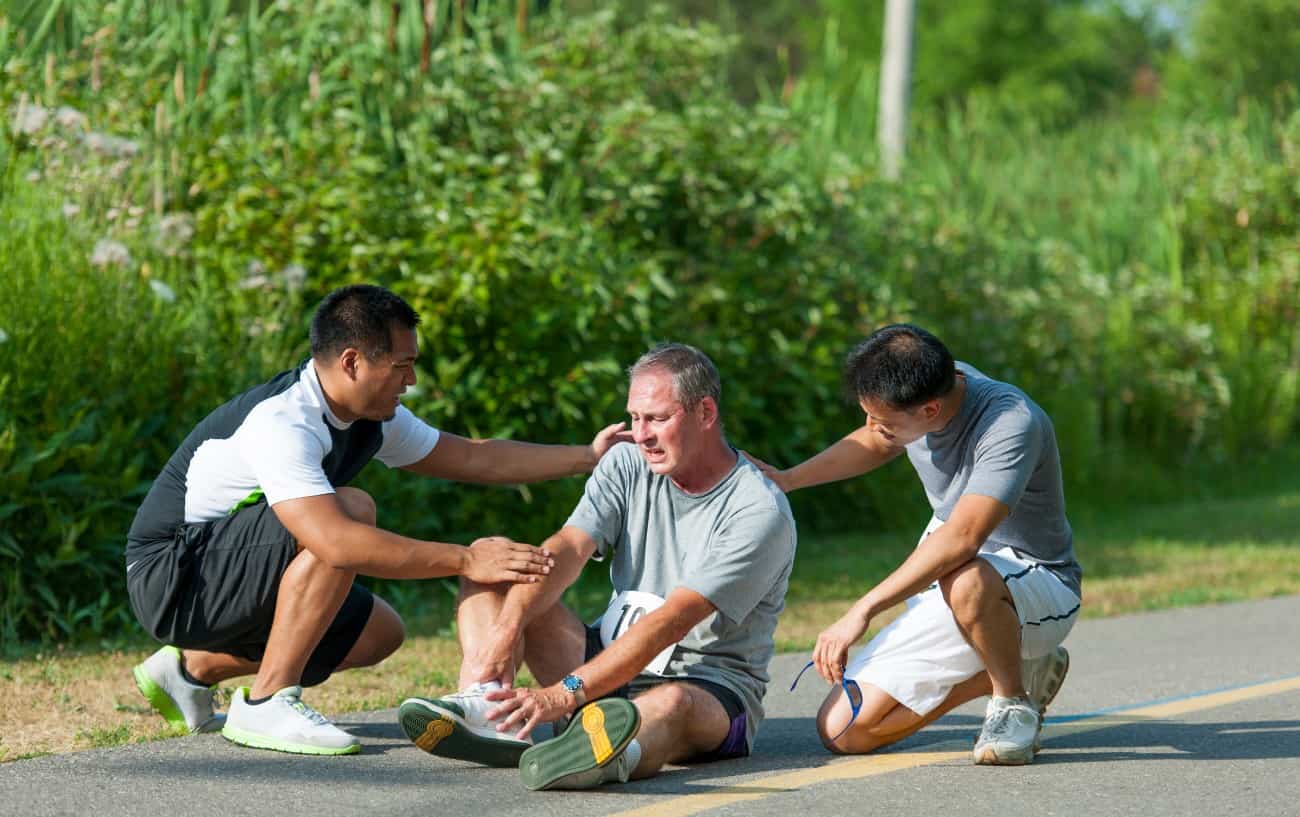
What Are the Most Common Injuries From Running?
Most running-related injuries occur in the lower limbs:
- Foot
- Ankle
- Lower leg: Shin and calf muscles
- Thigh: Quads, hamstrings, femur
- Pelvis, Hips, groin, glutes
Aside from lower limb injuries, distance runners can also be at risk for back injuries. Here are some of the most common running injuries:
Most Common Running Injuries
- Plantar fasciitis
- Posterior tibial tendon dysfunction (PTTD)
- Achilles tendinitis
- Stress fractures
- Medial tibial stress syndrome (shin splints)
- Compartment syndrome
- Patellofemoral pain syndrome (runner’s knee)
- Patellar tendinitis
- IT band syndrome
- Piriformis syndrome
- High hamstring tendonitis
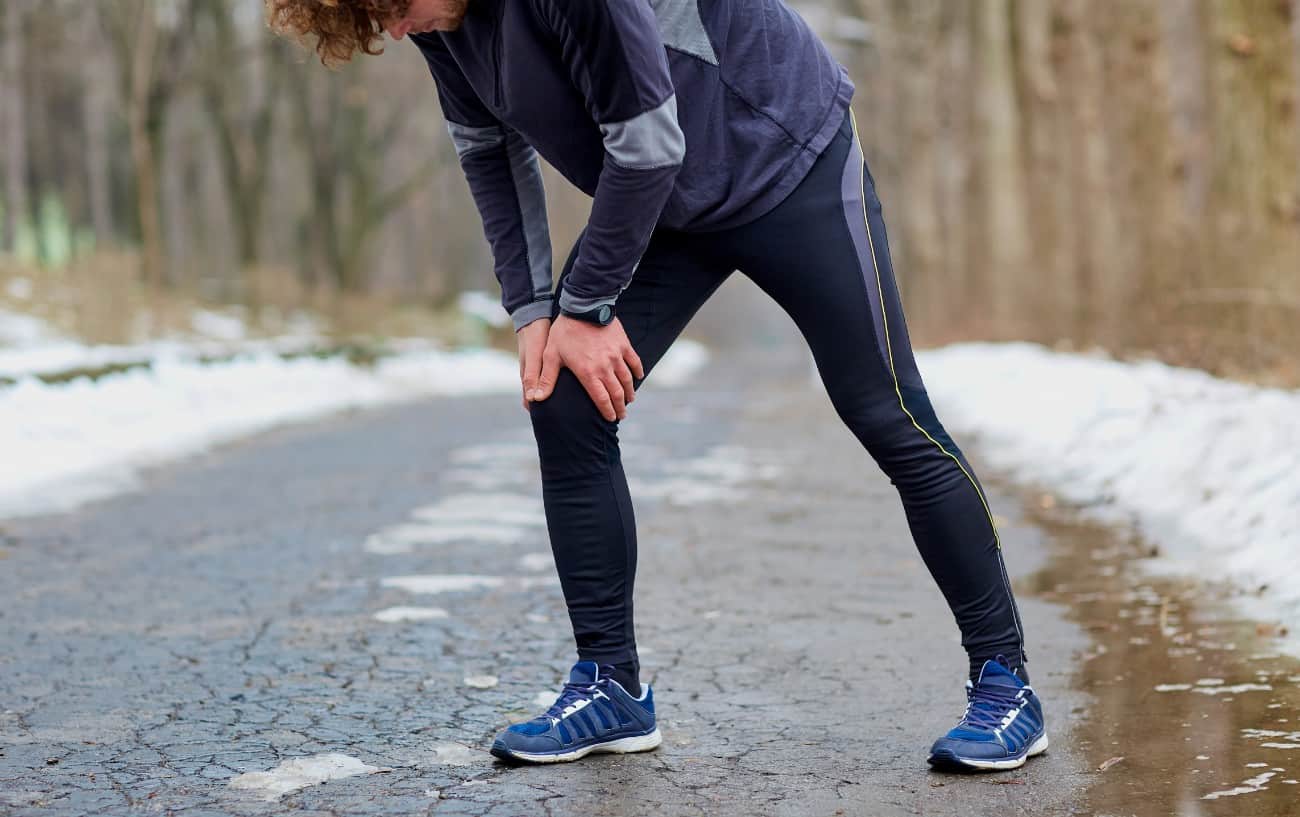
What Are the Best Ways to Prevent Running Injuries?
#1: Get Proper Running Shoes
As a certified running coach and personal trainer, I have consistently found that most runners are under the assumption that they are experiencing running-related injuries due to improper running shoes.
Ultimately, there isn’t a magic pair of running shoes that will keep you running injury-free, and research hasn’t found a strong association between a certain type of running shoes and injury prevention.
Generally, you should pick the running shoes that feel most comfortable to you.
In fact, a systematic review4Van Alsenoy, K., van der Linden, M. L., Girard, O., & Santos, D. (2021). Increased footwear comfort is associated with improved running economy – a systematic review and meta-analysis. European Journal of Sport Science, 1–13. https://doi.org/10.1080/17461391.2021.1998642 published in the European Journal of Sport Science, found that the incidence of running injuries decreases when runners choose running shoes that feel most comfortable. Plus, the rate of perceived exertion and running economy improved.
In other words, there isn’t a specific running shoe brand or type (stability running shoes, neutral running shoes, maximalist running shoes, zero drop running shoes, motion control running shoes, etc.) that is inherently better than the other types of running shoes.
Rather, the winning combination tends to be finding a running shoe that fits your foot shape and feels comfortable right out of the box.
If it is the right running shoe for your needs, it should feel comfortable right away, with no break-in period needed.
The most important step in running injury prevention and running shoes is replacing them as soon as they are worn out.
This is generally every 300-500 miles, depending on your body weight, type of running shoes, training frequency, whether you wear orthotics, etc.
Finally, it is valuable to rotate your running shoes by wearing multiple pairs on different training runs throughout the week.
Rotating running shoes has been found5Malisoux, L., Ramesh, J., Mann, R., Seil, R., Urhausen, A., & Theisen, D. (2013). Can parallel use of different running shoes decrease running-related injury risk? Scandinavian Journal of Medicine & Science in Sports, 25(1), 110–115. https://doi.org/10.1111/sms.12154 to decrease the risk of injuries by allowing the cushioning materials to fully rebound in between workouts and provide different levels of cushioning or stress application to your feet and legs.
For example, you might wear a maximalist running shoe for longer runs to provide excellent cushioning, while you might wear a firmer, lightweight shoe for speed work or tempo runs.

#2: Follow a Good Training Plan
There isn’t a single best training plan for all runners. You need to have a training plan that is appropriate for your fitness level and running goals.
Following an expertly designed training plan rather than flying by the seat of your pants and doing runs willy-nilly will help make sure that you are progressing at an appropriate rate, taking enough rest and recovery, and balancing easy runs with quality speed work.
Check out our training plan database, here!
#3: Don’t Overdo It
One of the most common training errors that increases the risk of injury for runners is either doing too much too soon or doing too many hard workouts without enough recovery or rest days in between.
Most running coaches follow the principle of the 10% rule, which means that you should not increase your mileage from one week to the next by more than 10%.
For example, if you are running 30 miles per week, you should not run more than 33 miles the following week.
However, the 10% rule doesn’t have clear guidelines for how to increase training intensity.
It is also important not to jump into speed work suddenly or increase the volume of high-intensity running each week.
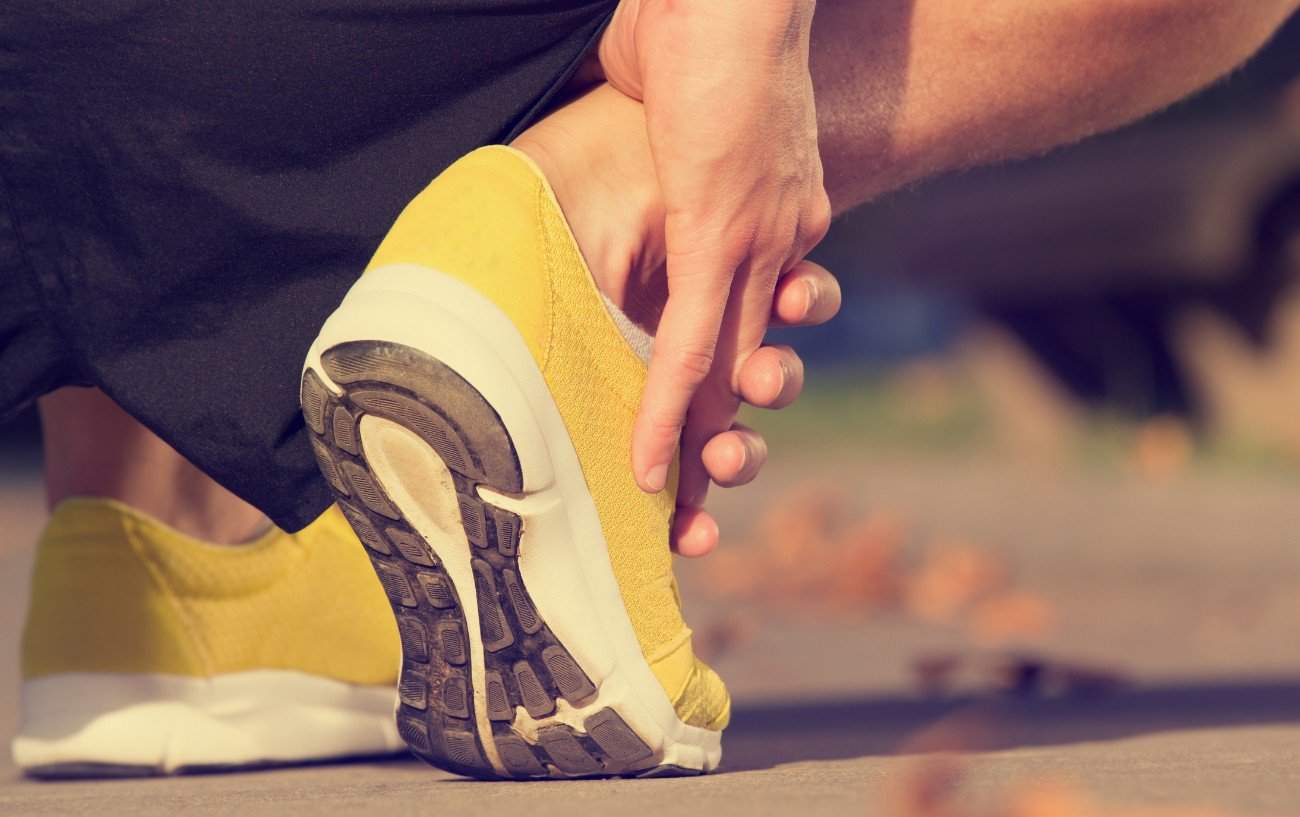
#4: Use the 80/20 Rule
The 80/20 rule of running states that 80% of your training volume should be easy runs at a comfortable pace, and only 20% should be high-intensity speed work, such as interval workouts, tempo runs, and racing.
#5: Vary Your Training
Incorporating different types of runs and paces will help vary the impact stresses on your body relative to plodding along at the same pace every day.
You should also vary your routes, especially if you run on sloped or cambered roads.
Softer surfaces like grass and trails may be easier on joints and bones than concrete and asphalt.
#6: Work On Your Running Form
Issues with your running form can be one of the key risk factors for running injuries.
As such, correcting running form and running technique issues is essential for running injury prevention programs.
For beginners and experienced runners with a history of injuries, it is important to get a professional running gait analysis from an experienced running coach, running shoe fit professional, or physical therapist who specializes in distance running.
Overstriding is the most common running form mistake that can increase the risk of injuries, but it is not the only running form problem that may be causing running injuries.
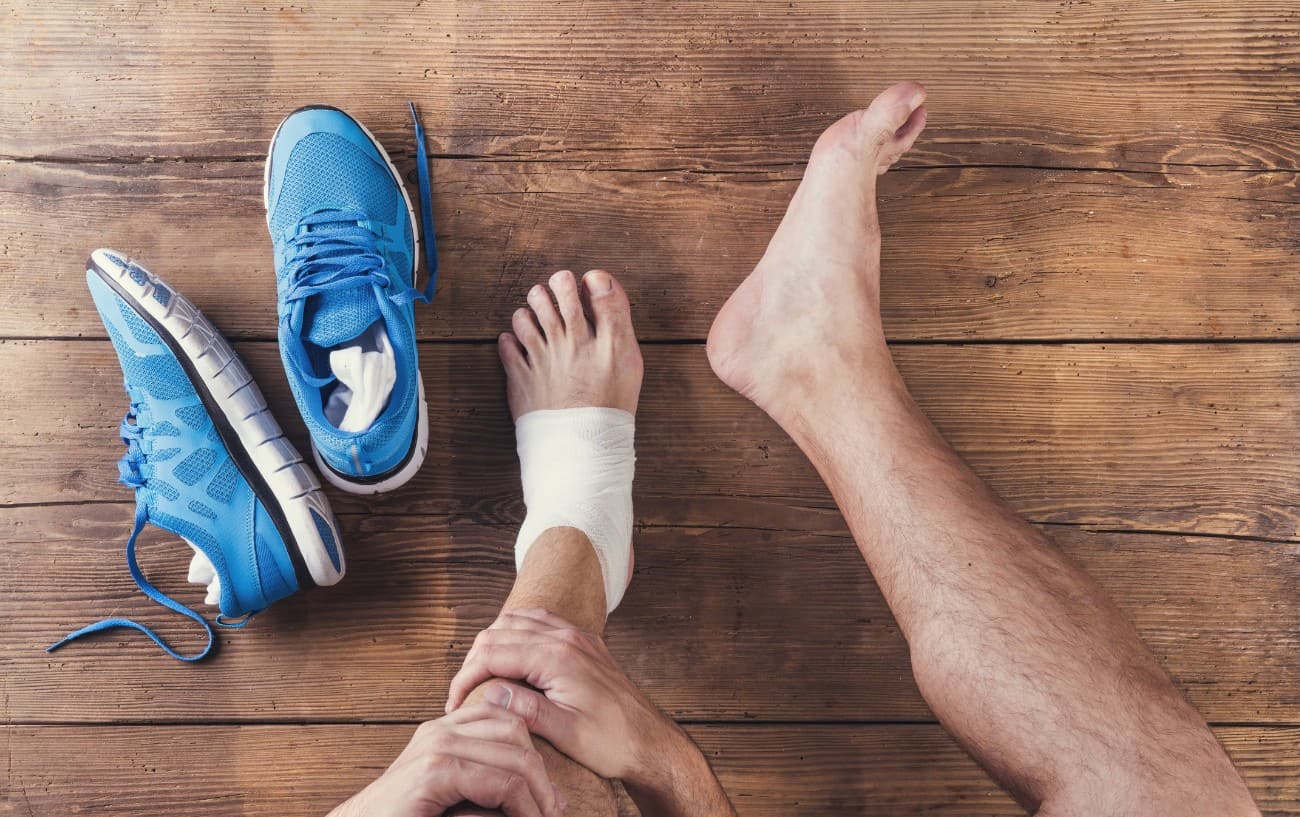
#7: Always Warm Up and Cool Down
Although studies haven’t demonstrated a statistically significant benefit of stretching,6Lauersen, J. B., Bertelsen, D. M., & Andersen, L. B. (2013). The effectiveness of exercise interventions to prevent sports injuries: a systematic review and meta-analysis of randomised controlled trials. British Journal of Sports Medicine, 48(11), 871–877. https://doi.org/10.1136/bjsports-2013-092538 doing a warm up and cool down can help prepare your body for your workout and facilitate recovery and reduce muscle soreness afterwards.
#8: Incorporate Strength Training
Studies suggest that incorporating strength training into your overall training program is one of the most effective ways to reduce the risk of running injuries.
A 2013 systematic review and meta-analysis7Lauersen, J. B., Bertelsen, D. M., & Andersen, L. B. (2013). The effectiveness of exercise interventions to prevent sports injuries: a systematic review and meta-analysis of randomised controlled trials. British Journal of Sports Medicine, 48(11), 871–877. https://doi.org/10.1136/bjsports-2013-092538 of randomized control trials conducted at the Institute of Sports Medicine Copenhagen evaluated the results of 25 studies encompassing 26,000 runners who had encountered a total of over 3,500 injuries from running.
Results revealed that strength training was runners’ most effective injury prevention strategy, with a relative reduction in injury risk by about 68.5%.
Strength training exercises such as squats, lunges, split squats, deadlifts, single-leg balance, planks, single-leg glute bridges, and plyometrics can make runners more injury-resilient.
Strength training strengthens the muscles, bones, joints, and connective tissues so that your own body weight is less of a “stress“ or load.
Strength training workouts can also improve your neuromuscular coordination, identify and correct muscle imbalances, improve core strength, increase your ability to have good posture and running form, and improve your running economy.8Šuc, A., Šarko, P., Pleša, J., & Kozinc, Ž. (2022). Resistance Exercise for Improving Running Economy and Running Biomechanics and Decreasing Running-Related Injury Risk: A Narrative Review. Sports, 10(7), 98. https://doi.org/10.3390/sports10070098
Proprioceptive training, such as single-leg balance with closed eyes, has also been shown to be an effective running injury prevention technique, reducing relative injury risk in runners by over 50%.
All these benefits of strength training for runners can set you up for a greater chance of injury-free running.

#9: Correct Muscle Imbalances
Muscle imbalances certainly increase the risk of common running injuries.
For example, weaknesses in the vastus medialis, one of the quadriceps muscles, can increase the risk of runner’s knee.9Kunene, S. H., Ramklass, S., & Taukobong, N. P. (2018). Anterior knee pain and its intrinsic risk factors among runners in under-resourced communities in Ekurhuleni, Gauteng. South African Journal of Physiotherapy, 74(1). https://doi.org/10.4102/sajp.v74i1.452
I highly suggest doing a few physical therapy sessions to identify muscle imbalances and develop a strength training program to help you correct these issues to help prevent injuries.
#10: Address Issues
Studies suggest10van Poppel, D., van der Worp, M., Slabbekoorn, A., van den Heuvel, S. S. P., van Middelkoop, M., Koes, B. W., Verhagen, A. P., & Scholten-Peeters, G. G. M. (2020). Risk factors for overuse injuries in short- and long-distance running: A systematic review. Journal of Sport and Health Science, 10(1). https://doi.org/10.1016/j.jshs.2020.06.006 that a history of a previous running injury is one of the most significant risk factors for running injuries.
Instead of just passively giving your body time for the injury to heal while you do cross-training workouts, you should try to identify and address the underlying causes.
Physical therapy, correcting your running form, changing running shoes, tweaking your training plan, etc., as needed, will help fix the root cause and, therefore, be one of the most important steps for preventing running injuries in the future.

#11: Fuel Your Body
Underfueling by being in a caloric deficit or following a weight loss diet or other restrictive diet that eliminates certain food groups and nutrients sets your body up for compromised recovery. This can increase your risk of injury.
Relative Energy Deficiency In Sport (RED-S)11Statuta, S. M., Asif, I. M., & Drezner, J. A. (2017). Relative energy deficiency in sport (RED-S). British Journal of Sports Medicine, 51(21), 1570–1571. https://doi.org/10.1136/bjsports-2017-097700 is a common problem with recreational runners and competitive runners trying to get leaner or lose body fat for running.
It can also happen unintentionally if you run high mileage and aren’t conscious of how many calories you need to eat.
RED-S increases the risk of stress fractures12Rachel. (2021, July 13). Relative Energy Deficiency in Sports syndrome (RED-S) and stress fractures. QSP Physiotherapy & Massage. https://qsp.physio/red-s-and-stress-fracture/?v=6cc98ba2045f and can compromise hormonal balance and muscle recovery.
It is important to fuel your body before and after training sessions, focusing on getting enough calories, complex carbohydrates, and protein to replenish glycogen stores and repair muscle damage.
Additionally, fasted running can increase muscle protein breakdown.
On the other hand, there’s some evidence to suggest13Winter, S. C., Gordon, S., Brice, S. M., Lindsay, D., & Barrs, S. (2020). A Multifactorial Approach to Overuse Running Injuries: A 1-Year Prospective Study. Sports Health: A Multidisciplinary Approach, 194173811988850. https://doi.org/10.1177/1941738119888504 being overweight can increase the risk of some common running injuries.
Therefore, working with a registered dietitian or sports nutritionist can be a keystone in your running injury prevention program.

#12: Don’t Neglect Cross-Training Workouts
Low-impact cross-training workouts reduce the impact stress of running and utilize different muscle groups differently.
This can help reduce the risk of overuse injuries while still giving you a great aerobic workout.
Running high mileage may increase the risk of injury,14van der Worp, M. P., ten Haaf, D. S. M., van Cingel, R., de Wijer, A., Nijhuis-van der Sanden, M. W. G., & Staal, J. B. (2015). Injuries in Runners; A Systematic Review on Risk Factors and Sex Differences. PLOS ONE, 10(2), e0114937. https://doi.org/10.1371/journal.pone.0114937 so scaling back easy runs in favor of cross training may possibly help you reach your running goals while decreasing the risk of overuse injuries.
#13: Get Enough Sleep
Sleep is essential for overall health and wellness and recovery from training.
According to the National Sleep Foundation, adults should be getting 7 to 9 hours of sleep per night,15Hirshkowitz, M., Whiton, K., Albert, S. M., Alessi, C., Bruni, O., DonCarlos, L., Hazen, N., Herman, J., Adams Hillard, P. J., Katz, E. S., Kheirandish-Gozal, L., Neubauer, D. N., O’Donnell, A. E., Ohayon, M., Peever, J., Rawding, R., Sachdeva, R. C., Setters, B., Vitiello, M. V., & Ware, J. C. (2015). National Sleep Foundation’s updated sleep duration recommendations: final report. Sleep Health, 1(4), 233–243. https://doi.org/10.1016/j.sleh.2015.10.004 but distance runners who are following a running plan may need additional sleep to support recovery.
Studies16Milewski, M. D., Skaggs, D. L., Bishop, G. A., Pace, J. L., Ibrahim, D. A., Wren, T. A. L., & Barzdukas, A. (2014). Chronic lack of sleep is associated with increased sports injuries in adolescent athletes. Journal of Pediatric Orthopedics, 34(2), 129–133. https://doi.org/10.1097/BPO.0000000000000151 have found that sleep-deprived workouts increase the risk of injury.
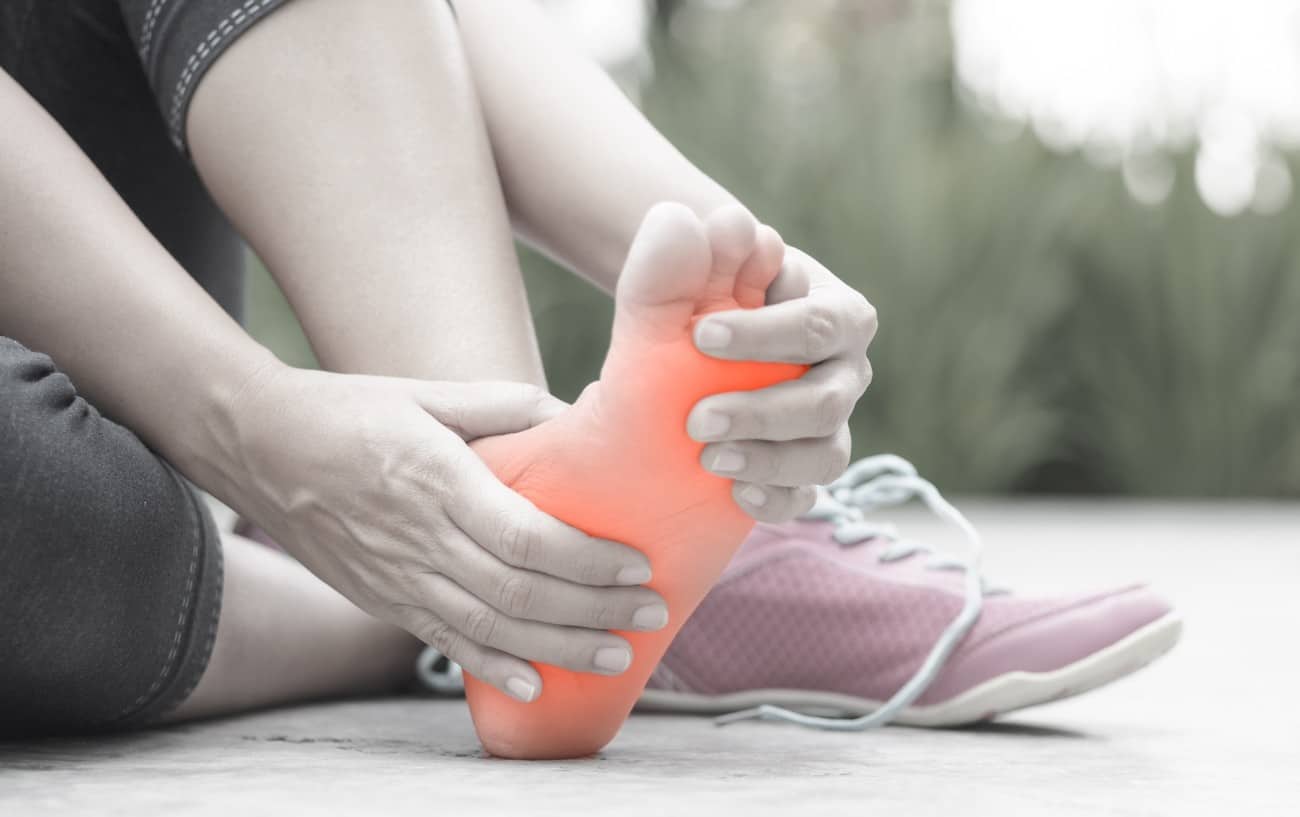
#14: Manage Stress Levels
The body responds to all forms of stress the same way, whether it is the positive stress of your training sessions or the negative stress of losing a job, struggling financially, not getting enough sleep, etc.
Stress increases cortisol levels17Mayo Clinic . (2021, July 8). Chronic stress puts your health at risk. Mayo Clinic; Mayo Foundation for Medical Education and Research. https://www.mayoclinic.org/healthy-lifestyle/stress-management/in-depth/stress/art-20046037 and stimulates the sympathetic nervous system (the fight-or-flight response).
This increases heart rate and respiration rate and compromises health and healing when it becomes chronic.
Stress management techniques such as mindfulness meditation and breathwork exercises can be helpful for preventing injuries if you notice that stress is an issue in your life.
#15: Listen to Your Body
One of the most important steps in any running injury prevention plan is to listen to your body.
Even if your training plan tells you to go for a 6-mile run or a 20-minute tempo run, if you feel like you are tired, experiencing excessive muscle soreness, have aches and pains, or are teetering on the edge of overtraining, it is way more important to swap the work out for a rest day or cross training workout as needed than to follow your running plan to a T.
What are your secrets to injury-free running?
For more injury-related content, check out our database for running injuries, where we have in-depth articles on a whole host of running injuries, from running cramps to running earaches:












